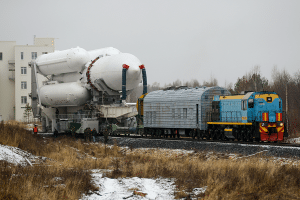Latest News
[Via Satellite 03-20-2015] In a press conference at SATELLITE 2015 for International Launch Services (ILS), the U.S. subsidiary of Russia’s Khrunichev State Research and Space Production Center, Andrey Vladimirovich Kalinovsky, the acting director of Khrunichev, discussed the imminent switchover from the Proton launch vehicle to Angara in the midst of international sanctions and a government takeover.
“The last few years were not necessarily the best ones for our enterprise,” said Kalinovsky, speaking through an interpreter. “Nevertheless we took some serious steps to overcome these difficulties. We brought in fresh blood from the neighboring industries; we brought in personnel having experience and expertise in solving similar problems. We have developed the strategic plan of improving reliability and streamlining production.”
“There will be a focus on more automation and less human involvement both in the manufacturing and the inspection,” added Phil Slack, President of ILS at the conference. “There will be more streamlining in the production of the number of plants and facilities, we will be looking at more of a streamlined production approach where metal comes in one door and a rocket goes out the other door.”
This move is part of a massive reform of the Russian space industry at large, including the creation of a sizeable and singular entity in January of this year that will effectively eliminate Roscosmos and take on the duties of the Russian space agency as well as the United Rocket and Space Corp. (URSC) — a company formed in 2013 to oversee the troubled industry. This move to a new Russian space industry, which is to be headed by Igor Komarov, current head of the URSC, obviously taps concerns about stifling competition within the Russian space market as the entity that manufactures satellites and rockets, now purchases them as well.
“Fortunately, this is not the first state-run organization to be set up in Russia. We have plenty of experience of operating such agencies,” said Kalinovsky, citing the country’s nuclear energy corporation Rosatom and Rustech, the state-run entity responsible for technologies.
International sanctions recently imposed on Russia by the United States also raise concerns for the space industry. While representatives noted there was a slight pause in licensing as sanctions took hold, they said Khrunichev operations went completely unaffected.
“Most of the sanctions — not all, but most of the sanctions — have been focused on individuals as opposed to large sectors. We believe there’s a large interdependency between Russia and the West when it comes to space and so we believe the operations will continue without anomaly,” Slack said, referencing recently stressed relations over the International Space Station (ISS), as well as Orbital ATK’s decision to replace the Russian-made AJ26 engine on its failed rocket launch with the hopefully more reliable Russian-made RD-181.
In the midst of a shifting economic and political climate, the agency has announced the discontinuation of its Proton launch vehicle in favor of the long-awaited Angara family of rockets that, the agency says, will have three basic variants: a single core version, triple core version for medium lift, and a heavy lift version with five cores.
“Angara is a totally new product; it is based on a modular design and this universal core is becoming the fundamental for the entire family of launch vehicles who have heavy lift, medium lift and small lift capabilities. Comprehensive tests will be completed in 2021 — that’s when the vehicle will be offered commercially — and we expect by 2025 it will replace Proton entirely,” said Kalinovsky.
The agency is currently seeking customers for its Angara 1.2 launch vehicle, which was flight-tested last year and can lift an estimated 3 metric tons to Low Earth Orbit (LEO). Angara 3, the medium lift version, will be capable of handling 14 metric tons to LEO for the launch of constellations. The heavy lift version, Angara 5, is notably more complicated, however.
“We can confirm that next Angara launch of the heavy lift version will occur in early 2016,” Kalinovsky said, but the agency admitted that there were several issues that needed to be resolved before the launch. “Today, the only active launch site that’s capable of launch Angara is Plesetsk, which is high up near the Arctic Circle, and so it’s really not conducive for launching payloads to [Geostationary Transfer Orbit] GTO.”
The agency is currently building a launch site on the east cost, called Vostochny, set for completion in 2021 that will be capable of launching Angara 5. And while there will be some overlap between 2021 and 2025 while Angara is phased in and Proton is phased out, the agency is vehement that the old model has seen the last of its heyday.
“We live in a very, very competitive world and it would be more expensive to keep two different product lines going; you wouldn’t get the economies of scale, you wouldn’t get the learning curve, you wouldn’t get the economics,” Slack said.
Dmitry Rogozin, deputy prime minister of Russia, visits the new Vostochny Cosmodrome routinely to keep the project on schedule, which is now under close watch after construction delays pushed back its intended completion date.
Get the latest Via Satellite news!
Subscribe Now